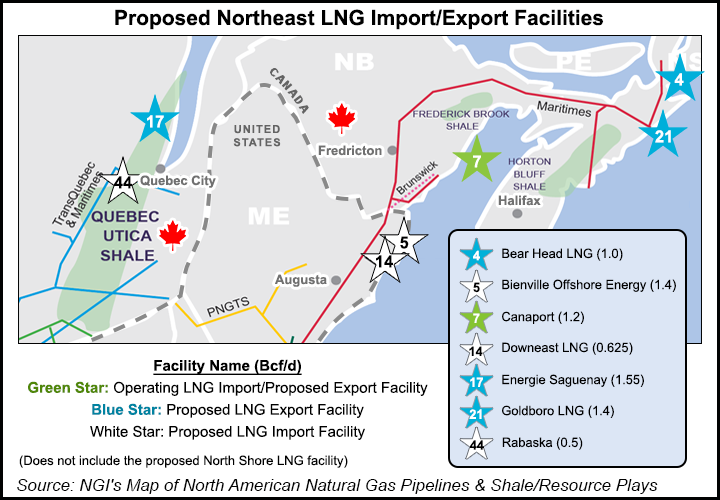Infrastructure | LNG | NGI All News Access
Nova Scotia LNG Project Would Access Canadian Gas Via U.S. Pipes
Bear Head LNG Corp., which is developing a liquefied natural gas (LNG) export terminal in Nova Scotia, is seeking authorization from the U.S. Department of Energy (DOE) to import and then re-export western Canadian natural gas to supply the terminal.

Gas “…would be imported at the various existing — or future — points at the U.S.-Canada border along the Western Canada-Northeast and Western Canada-Midwest pipeline corridors, which traditionally have linked western and central Canadian supply areas to U.S. Northeast and Midwest demand regions,” Bear Head told DOE in its recent filing.
In an earlier filing, Bear Head asked DOE for authorization to export U.S. natural gas to Canada for a 25-year period in support of the project (see Daily GPI, Dec. 10, 2014). Import and re-export of Canadian gas would also be for a 25-year period under Bear Head’s plans.
“An ample supply of natural gas is available throughout Canada, particularly from the Western Canadian Sedimentary Basin (WCSB), and from the Mackenzie Delta, Eagle Plain and Peel Plateau in the Northern Gas Region,” Bear Head said. “Additionally, the potential exists to source gas from the Central Canadian regions of Ontario and Quebec. This supply can be sourced in large volumes in the spot market, or pursued under long-term arrangements.”
While Bear Head has said it wants to export liquefied U.S. gas — particularly that from shale plays — from its terminal, it touted the abundance of gas in Western Canada. “Even with the growth in unconventional gas production in the United States over the past decade, the WCSB still remains the second-largest producing basin, only trailing the U.S. Gulf Coast.”
Bear Head said there are more than 10 “major” points of entry where WCSB gas could enter the U.S. interstate pipeline system, many of which could carry WCSB gas to the Maritimes & Northeast Pipeline (M&NP), which would deliver gas to the terminal.
“WCSB supplies have numerous combinations of paths to reach the M&NP system,” the filing said. “The continued development of WCSB unconventional gas prospects could spur additional export volumes to the U.S. North American pipeline flow patterns have changed dramatically over the last five years, creating new paths to existing markets.”
© 2024 Natural Gas Intelligence. All rights reserved.
ISSN © 1532-1231 | ISSN © 2577-9877 |
